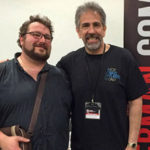Former Bowie bassist talks about famous collaborators and trusting his instincts
By David Sands
August 24, 2016
When it comes to music, Carmine Rojas trusts his heart to take him where he needs to go. It’s an instinct that has brought him great success; the bassist’s intuitive, playful touch has allowed him to put his talent in the service of artists like David Bowie, Rod Stewart and Joe Bonamassa. In fact, he can be heard strumming his bass on some of Bowie’s biggest hits, songs like “China Girl,” “Modern Love” and “Let’s Dance.”
Known for his mastery of rock, funk, Latin, R&B, jazz and other styles, he’s also been found playing with the likes of Carlos Santana, Tina Turner, Julian Lennon, Mick Jagger, B.B. King, Billy Joel and Herbie Hancock.
Right now, Rojas is a member of Ziroq, a world music group that draws from different genres, especially rock and flamenco. FBPO’s Jon Liebman recently caught up with the talented Mr. Rojas to find out more about his incredible career and mountain of influences, as well as his free-spirited and deeply instinctual approach to playing the bass.
FBPO: You’ve got an interesting background. You’re from New York and you seem very proud of your Puerto Rican and Latin heritage.
Rojas: I’m very proud to come from Brooklyn. [I’m] pretty much a product of the late 1950s and ‘60s [there]. And to achieve as much as I achieved, never actually realizing this was what’s going to happen to me, it’s quite [an achievement]…being involved in English rock…playing with Bowie and the Rolling Stones. I really treasure being in these bands. I feel that maybe eight of us were privileged to be able to be on game, on point, and able to do these things with these artists, which was a beautiful chance. Most English bands came to New York in the ’80s [and ’90s] — I guess, Mike + the Mechanics, Bowie and Joe Cocker, Steve Winwood — and they would use all New York players. And there were a lot of us, and a lot of us were available to be on these albums. It’s quite fortunate. It was in the midst of the Spanish and black R&B, Puerto Rican [music scenes]. They liked how we would interpret the rock music. We would interpret a groove, and it didn’t have to be straight Latin, straight R&B. We knew how to play it, and it would be a kind of pop kind of bass. And they were very smart how they used us, how they included us in the process.
FBPO: Did you ever cross paths with Eddie Gomez?
Rojas: Eddie Gomez, the bass player? Yeah, many times.
FBPO: He’s another Puerto Rican bass player who grew up in New York, so you have that in common.
Rojas: Yeah. There’s a lot of us. There’s a lot of great, great awesome players who just meet up. Sadly, we don’t have a name, which actually isn’t that important, but still great players…some of us in Latin [music] playing stuff like the Merengue and the salsa and the Latin stuff, which is very strict. I’m kind of a guy that doesn’t like to be that strict. I like living on the edge a bit. Controlled chaos, I call it, which I love very much — to be on that kind of scene where it’s kind of controlled but still chaos and you’re just on the edge. I love interpreting what War did and Santana did back in the ’60s and the early ’70s, when they would interpret the Latin into the rock thing. And I always love how that was possible to do because the way of the music it works. Fantastic! Traffic used to do a lot of Latin in their sets. I saw a great jam with them; it was Santana and Traffic playing together. It was very cool. This was like ’71. And it was very cool to see that. And they actually did it correctly and made it feel right.
FBPO: What attracted you to the bass?
Rojas: It’s funny, I started on drums, but my younger brother was better at it. And bass somehow had such a way of vibrating the cavity of the body, something about the tone when you hit a note. …At that point in time, there was a lot of music with bass in it and, you know, bass solos. There was Cream playing with Jack Bruce and a lot of Latin players and certain notes they’d hit that would resonate. And you’d go: “What is that note and why is it doing that to me?” It’s got a very effectual line opening. The way certain notes are played, and, when it’s right, it’s just like very powerful; and the bass would dominate when I learned what the trick was. You’d have a guy playing, say: G, C, D; the bass would go: B, A, D-Flat. I could do that sort of thing, and it would dominate; it would control the situation. One note, it would change where everybody’s headed.
FBPO: You mentioned Jack Bruce. Who were some of your other bass influences or bass heroes?
Rojas: Oh man, from the English guys it was John Paul [Jones], Chris Squire, Jack Bruce. Their interpretation of what they were doing, especially Chris Squire and John Paul when he played with Zeppelin, especially when they started on the second album. …I love the Latin guys, R&B guys: James Jamerson and Chuck Rainey. Ray Brown for upright. I would incorporate all that stuff and kind of find what I like from each one of them and just borrow like we all do on licks and lines, and then somehow a door would open; a different door would open, and I would go that way. I always loved it.
FBPO: Did you ever play upright?
Rojas: Yes, quite a bit. I still do, but now I have a left shoulder that’s hard to keep my arm straight, especially for the upright. You need a good straightened hand, but that’s another instrument where you hit a single note and when it growls, it’s gorgeous. And it plays beautifully. There’s a difference between Stanley Clarke playing electric and upright, and I love the way he plays upright. …Ray Brown is gorgeous. Ray Brown’s an old favorite and Bill Evans who passed away.
FBPO: Scott LaFaro?
Rojas: Yes, absolutely. Beautiful heart and a guy who should have been credited and should have on the same level as everyone else.
FBPO: Wilton Felder?
Rojas: Wilton Felder was great. …You know the bass player…on Conan O’Brien, Mike Merritt? You know who his father is? His father [Jymie Merritt] was from an amazing band, Art Blakey [and the Jazz Messengers]. Now, his father is one of those that should have been credited high up, because he had a great way of coming up with parts that were [popularized]. His father is absolutely genius, and he should be on the same level as the rest of the guys who are still named. …He’s one of the first few guys — when I moved to Philly between the years ’70 and ’79 — I went to his shows. And he, Mike Merritt’s dad was one of the first guys I seen live, when I started venturing into more jazz at a young age…absolutely beautiful. So, you venture down that route, and you grab stuff that touches you and moves you; and there’s just so much to grab when it comes to being a musician, a real true musician…or even non-players who know how to listen. Non- musicians, people who buy stuff, LPs and CDs. They don’t play, but they know what they hear, and God bless them!
FBPO: It’s great to hear that you’re such a music fan. You’ve played and toured and recorded with so many musical heavyweights. I’ve got to ask you about Bowie. I mean, you were with him for a long time. Tell me a little bit about that experience and what kind of guy was Bowie to work with.
Rojas: The honest truth — coming from my times living and staying with him and hanging out with him — the guy was actually really ingenius, a great artist as a painter, a great leader. He didn’t have to say much; he just kind of looked. He’d direct traffic. He knew what he wanted, when he wanted it. He would have us switch instruments. Sometimes great players, they play too good, so he had us switch instruments, which that was the first time with me ever doing that — me jumping on drums or trying playing keys. And I went: “Wow, what confidence he had.” And it’d sound like crap, but he could hear crap. He knew how to polish a turd [laughs]. As a person, absolutely never, never highbrowed any of us; he being English and us being black and Puerto Rican. We were always treated equal, and whenever a situation was going down, we would invite him to go to dinner. He was never a separate cat, you would think, like someone higher up. We would hang out all together all the time, because that’s what he liked.
FBPO: That’s good to hear.
Rojas: He was actually one of the few genuine beautiful men on the planet. First, I couldn’t believe I was part of it, because I was such a Bowie fan. You know, there’s some heroes you meet, you know: “I should have never met ’em.” That kind of stuff goes on quite a bit. …I have nothing to say, ever, negative about him. He was always positive, never pissed off. …He just kept even keel. …But the relationship with Bowie working-wise was very free, very open. He knew how to direct traffic, like I said, and we would always experiment. We would never want to repeat the same albums. …We just kind of trusted where he was thinking at the moment, what he was feeling. And the demos were really pretty rough, but you could hear coming through the stuff, coming out of it. So we would try to copy the demo and put the old stuff in it and see, which one worked and then we would keep all the material.
FBPO: Playing with a guy like Joe Bonamassa must feel like a real change of pace after Bowie and Rod Stewart and Julian Lennon, Tina Turner, John Waite and all those others…
Rojas: What it brought to me, playing with Bonamassa in the beginning — because it was when nobody really knew him — what it brought back to me was those English guitar players like Clapton and Jeff Beck and Jimmy Page. And I have to include Hendrix, ’cause he was more European than American — the kind of style that they played. ‘Cause I was a big fan as a kid.
I used to go to the Fillmore to see the Jeff Beck Group. I used to go see The Move. I used to go see Bonzo Dog, early Zeppelin, when they first came over. …It was just really cool how these guys were into… they wanted to be soul singers. They wanted to be an R&B band, but they couldn’t do it; they didn’t have the soul. But what they did, their interpretation was so unique, that helped put them on the map. The first Jeff Beck album, when you listen to it, you go: “Wow this is really, I have no clue what they’re doing, but they know what they’re doing because they feel what they’re doing, those guys.” And they brought the blues back to America. That’s how much geeked they were into it: John Mayall Blues Band, Clapton…but the Jeff Beck group was a big eye-opener for me, watching Ron Wood on bass guitar, bass playing with a Telly bass, which is why I got the Telly bass, because of Woody — that’s how much of an influence he is on me. Many years later, I did tell him the story; he started laughing.
FBPO: What about Phil Chen? Was he on your radar too?
Rojas: He was on the radar on Blow by Blow, when that came out…and Clive Chapman, a bass player who was playing on the Jeff Beck Group, the third album, when Jeff changed the band and got Cozy Powell on drums. Clive Chapman was like a real English R&B bass player, out of England, and did a great job on making those tracks. I think the album is called Rough and Ready, Jeff Beck Group. And those are great albums. There’s some great bass playing there. When you listen to it, it sounds a bit dizzy. But that’s how bass players were leading the way; they were actually James Jamerson style and the bass had a lead instrument [role] and never got in the way of the lead vocals or anything else. You have to be pretty clever to think up that stuff.
FBPO: Transitioning to that concept to bass, I was watching an interview with you, and you were making a distinction about, as a bass player, your role as a supporting member of the band versus somebody who needs to take solos. I know you have something to say about that.
Rojas: Yeah, with Bonamassa, I’m actually soloing the whole night, but in the protective mode to take care of the guy in front. Because I’m old school. And we protect the guy up front [and] the person right behind you; you protect them and make them look good. So the rhythm section, very important to me that the drummer…that guy is happening; ’cause he’s not happening, it’s going to fall flat. So you have a great rhythm section, you can play around, especially when it comes to the blues stuff. That’s what I do: I play around. You can change it, move notes around, so it wouldn’t be just standard blues. Because anyone can play standard blues; they can do it and sound great. I just like experimenting, playing more War music, bassline inside of it. With Bonamassa, I was able to do that, which gave the freedom to bring in Latin roots and R&B roots and still do English style bass playing, because it’s a different approach than the American-style bass playing. And Joe loved that, that I would bring in all that to the table. And we were both fans of the same bands, the Jeff Beck Group and all that kind stuff.
FBPO: Tell me a little more about what’s keeping you busy these days.
Rojas: Right now, I just finished a massive six-week European tour, which I went out in April-May-June with a new guitarist named Ryan McGarvey. Somehow his bass player and his drummer bowed out…and he had to do this tour, or it would have pushed his whole career stuff a year back. So this company in Germany — I know a few specific companies in Germany — called me up and said: “Hey, we need some help. We don’t have the money, but we need somebody to mentor Ryan, so we don’t lose the year.” I said: “Well shit, I’ll come over there and visit my friends. I’ll come up, and just make sure I have a single room, we’re able to travel around, and there’s food involved.” And that’s what I did; I did the set for six weeks. …I like doing these kind of things where I can mentor somebody or be a part of [a tour] and then be unchained and do it freely. …Ryan is a great guitar player and a decent singer. Some of his backup material was a little weak, but we beefed it up — this drummer and I — and put some life to it. And there’s live footage on the Facebook page: Carmine Rojas fans!!. You’ll see quite a few of them on there. And you’ll see the world band that I’m a part of too, which is very interesting with a Lebanese singer—actually beautiful. If I can play other kinds of music, not just one style, it opens things up, helps it embellish itself. …I don’t have to solo, ‘cause I keep soloing inside of it by having whatever groove.
FBPO: I love how you have a genuine love of music. That’s beautiful.
Rojas: Yeah, it’s important. It’s one of the few things I have left. You know I’m 63. And it’s one of the few things that can touch me. You can play a note and hear a song and it will remind you of school. It’ll put you someplace. The memory that comes from the Motown hits or, you know, a Zeppelin song or something where you were at that point in time affects me. And I’m much more of a feel guy. I’m not much of a thinker. I’m much more of what comes from my heart and soul.
FBPO: What kind of equipment are you using these days? Xotic basses, right?
Rojas: Yeah, Xotic basses. I do, because…for me, it makes me feel like I’m playing a Fender, which is like my all-time favorite to play. If you like Fender basses like me, they just sound a bit more aggressive. But solo-wise the color, it just comes out more, and they’ve got better pickups out of it. You can play an old jazz bass, and it sounds great. But when you play one of theirs, it’s like it comes alive. And it’s really up to you, the way you play, for it to come alive, because it’s just a well-made bass, which I love. …I play it all the time — the five- [and] the four-string — and it never fails me. How they build the stuff and what it does live. …The basses are absolutely kickass! Fantastic stuff to play with. The four and five. I just put one away the last year. I just picked it up the other day; I was like: “Oh man, this thing still sounds good. And there’s a particular one live, a four-string that’s just absolutely fantastic.
I use Eden cabinets, Eden heads, and then something happens where I have to go to rent, I’ll go to [Gallien-Kruegers]. I feel safe with GKs. I been playing [with Eden] since ’94-’95. And I did it with the whole world tour with the Rod Stewart stuff, and I still got one of the original cabinets. I got the 2×10 cabinets. I got the 4x10s. I still got the two world tops to tour with, the 800 series.
FBPO: What about strings?
Rojas: I’ve been changing. I just went back to La Bella, which I haven’t since I was a kid. Xotic strings, I use their strings. D’Addario and a lot of Ernie Balls, which I’ve used their stuff a lot of years. And my early years with Bowie I would use Rotosound, the English strings, back in the day. I like the tautness and would play them when I used to play pick.
FBPO: What about the future? What else is in store for you?
Rojas: I’d love to be in [Peter] Gabriel’s band. A band like Gabriel’s where you can mix more music together, which is still pretty important to me. [I also have] a flamenco band. Most flamencos, they don’t have any basses and there’s only two bass players that actually play flamenco proper: a guy named Carlos Benavent and Paco de Lucía. And I love that style. I love the education; it’s Arabic, Indian, Hasidic. The scale, the classical scale they use. Flamenco came from India and parts of Persia, and by the time it got to Spain it morphed into the flamenco that we know now, with the Spanish guitar and the vocals. When you hear the vocals and chord changes, it’s Arabic: flat-two and a raised-five. …And for me, it’s beautiful because you get to blend it all of it together. And you can use [Led Zeppelin’s] “Kashmir” as a template, because when that came out…I couldn’t believe what I was hearing. …And that, to me, is a great template with the band I have, a band called Ziroq, and [for] Marcus Nand, who’s the guitarist and vocalist, on his solo album. We’re still doing it, and that’s a project I’m trying to get signed. But you’ll see a video on my Facebook page, Carmine Rojas fans!!, about my live show and the woman’s name is Mayssa Karaa. This woman is a Lebanese singer who can sing Arabic, speaks about five different languages, which she’s doing. …It’s healthy. It’s educational scale-wise. When you incorporate it into the blues, it’s very cool. We used to have a show. I put changes in it using “Kashmir” from Zeppelin. When you can incorporate that kind of stuff, it takes it away from being the normal blues. But it’s still very powerful because Joe — something I love about Joe — he’s not afraid to go there. And same thing you could talk about Ryan McGarvey; he’s not afraid to go off that cliff. And you go with him, because you know you’re going to win it.
FBPO: Carmine, what would you be, if you weren’t a bass player?
Rojas: Oh geez, that’s a good one. If I wasn’t a bass player? Probably a mentor to somebody, somehow doing the same, probably focusing on getting a group of people together and us in the same way hitting for something majestic, something beautiful, something that’ll make people change where they are in a moment. …I’d hope to be the same kind of person. I’d hope to be the same kind of leader, leading people to a really peaceful and beautiful path. I’d love to be a great chef. I can guide or go along with someone who’s going to that majestic and beautiful place like where music touches you. I don’t know if it’s like that in anything else.








I WORKED WITH,PEE WEE CARMINE.WHEN HE WAS WITH PATTI LABELLE FROM 1969 1973.AS RODIE.WE BOTH ARE FROM BROOKLYN NY.AND OUR BIRTHDAYIS ON THE SAME DAY.